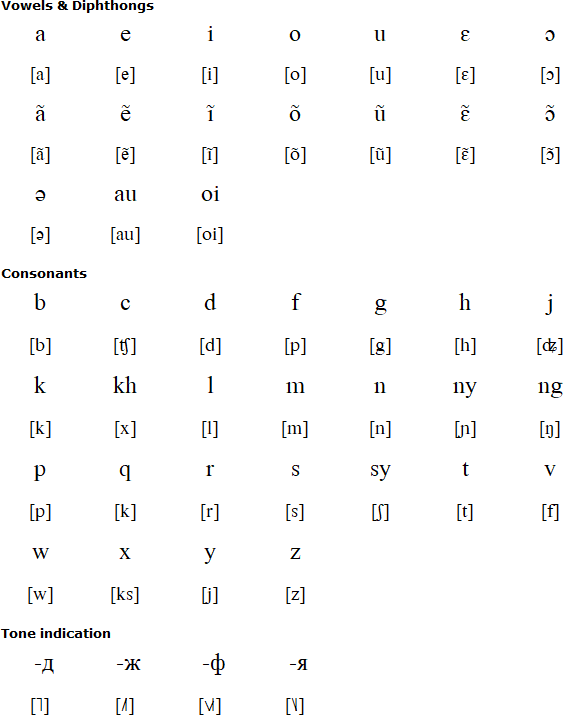by Teddy Nee

You may have heard about a Chinese dialect called Cantonese, haven't you? From the continent of America to Europe, you can find Cantonese speakers in many countries. And have you heard about Hokkien, or sometimes called "Fujianese" and "Taiwanese"? Hokkien speakers also make up a big portion of worldwide overseas Chinese, thus, there existed varieties of Hokkien language. I am a native Medan Hokkien speaker.
Hokkien is called "Taiwanese" in Taiwan. It is because of the variety of Hokkien spoken in Taiwan as we call "Spanish" to Castellano language because it is spoken in Spain. With my understanding of Medan Hokkien, it is indeed difficult to maintain a meaningful conversation with a Taiwanese Hokkien speaker; given the distance and history that has formed both kinds of Hokkien into distinctive languages. However, they are still called the same Hokkien language with different varieties.
One day I read about Rumantsch Grischun (Graubünden Romansh) that was created in 1982 by Heinrich Schmid, a linguist from Zurich, as a standardized written form of Romansh language. Romansh language is one of four official languages of Switzerland and is not, in fact, a single language but rather a cluster of closely-related dialects.
Given my experience and interest in constructed languages (conlangs), I got an idea to create a conlang that could serve as a universal Hokkien language.
The first conlang that I learned was Esperanto. The comments about how easy it is and how it could bring communication equality among speakers from various countries intrigued me to find out the reality of this language. It seemed to be a mix of Spanish, Italian, French, and some Romance languages, so I thought I must be able to understand these languages, right? Not entirely true because Esperanto is neither a universal Romance language nor an intentionally mixed Romance language, but many words are indeed derived from Latin.
After learning Esperanto, my journey of conlanging continued to other languages, such as Elefen, Toki Pona, Slovio, and the list goes on. I have indeed acquired quite a lot of knowledge and experience during my learning. Besides, I have also joined some Linguistics-related and conlanging-related online communities where hobbyists and linguists interact to share their passion or strive to make our lives better through languages.
The Hokkien spoken in Indonesia is mostly called “Medan Hokkien” because it is widely used in Medan city and surroundings. Medan city is located in North Sumatra province on the western part of Indonesia. Out of its 2.3 million some population, Hokkien speakers make up less than a quarter. You can imagine how small the number is compared with the whole country's population.
With the increasing demand for English and Chinese, many young Medan Hokkien speakers learn both at schools and some parents even use them in households hoping for their children a better future since English and Chinese are seem to have a high economic value in the world. I am afraid this will lead to the extinction of Medan Hokkien because the practice will reduce the number of its speakers gradually. In addition, there is no standardization and written form of Medan Hokkien, it is not registered officially as a language in the country, and it is even spoken mixed with Indonesian when the speakers don't know how to say a word in Hokkien.
Medan Hokkien certainly has strong factors to support its extinction.
Recalling the story of Rumantsch Grischun, my goal of making a Hokkien conlang is to create a universal Hokkien language. I name this conlang "Mohkien" - the first syllable is derived from the "M" of "Medan" and an inverted "OH" from "Hokkien". The base of Mohkien is indeed Medan Hokkien because this is the variation that I am familiar with the most. The rest comes from other Hokkien variations that I decide carefully through dictionaries and other resources. Another reason is to preserve and conserve Medan Hokkien in a different manner.
I have also created a writing system to facilitate users to learn and communicate better with one another. Besides, writing form of a language helps to protect it from extinction. This is why it is important to have a writing system for a language.

Download an alphabet chart for Mohkien (Excel)

There are articles and phrases that I have translated into Mohkien language, as well as the grammar, facts, and other related information. Inspired by Esperanto and Interlingua, I have even created a flag to have a practical visual representation of Mohkien language. Hokkien is originally a tonal language, thus, making Mohkien is also a tonal language. The inspiration for its tone markers comes from Hmong language's tone marking system.
Here is a sample of Mohkien language:
The development of Mohkien is still ongoing. Visit the Mohkien website to learn more about it.
Teddy Nee is a multilingual language blogger and IT engineer. He knows several languages and currently manages his blog Nee's Language Blog.
Written Chinese: Oracle Bone Script, Simplified characters, Bopomofo, Types of characters, Structure of written Chinese, Evolution of characters, How the Chinese script works, Xiao'erjing, General Chinese
Spoken Chinese: Mandarin, Dungan, Wu, Shanghainese, Wenzhounese, Yue, Cantonese, Weitou, Min, Jian'ou, Taiwanese, Teochew, Fuzhounese, Puxian, Hakka, Xiang, Gan, How many people speak Chinese?
Other Chinese pages: Chinese numbers (數碼) | Chinese classifiers (量詞) | Electronic dictionaries | Chinese links | Books: Chinese characters and calligraphy | Cantonese | Mandarin, Shanghainese, Hokkien and Taiwanese
Writing systems | Language and languages | Language learning | Pronunciation | Learning vocabulary | Language acquisition | Motivation and reasons to learn languages | Arabic | Basque | Celtic languages | Chinese | English | Esperanto | French | German | Greek | Hebrew | Indonesian | Italian | Japanese | Korean | Latin | Portuguese | Russian | Sign Languages | Spanish | Swedish | Other languages | Minority and endangered languages | Constructed languages (conlangs) | Reviews of language courses and books | Language learning apps | Teaching languages | Languages and careers | Being and becoming bilingual | Language and culture | Language development and disorders | Translation and interpreting | Multilingual websites, databases and coding | History | Travel | Food | Other topics | Spoof articles | How to submit an article
[top]
You can support this site by Buying Me A Coffee, and if you like what you see on this page, you can use the buttons below to share it with people you know.

If you like this site and find it useful, you can support it by making a donation via PayPal or Patreon, or by contributing in other ways. Omniglot is how I make my living.
Note: all links on this site to Amazon.com, Amazon.co.uk
and Amazon.fr
are affiliate links. This means I earn a commission if you click on any of them and buy something. So by clicking on these links you can help to support this site.
[top]